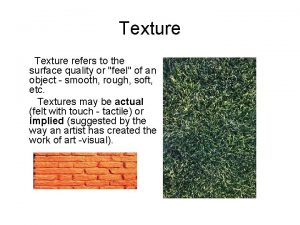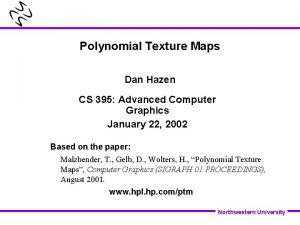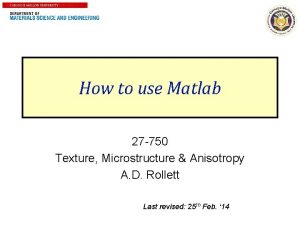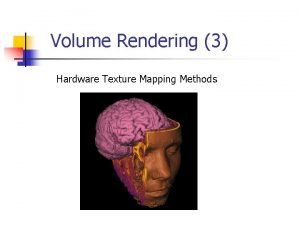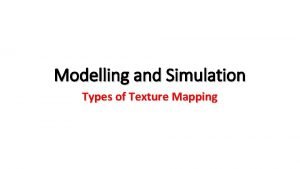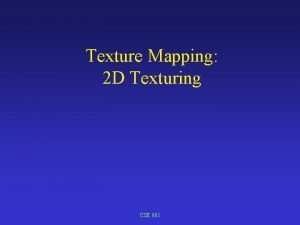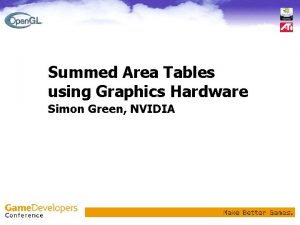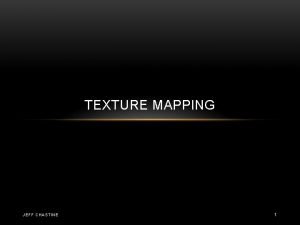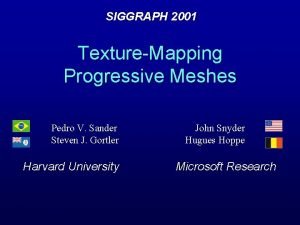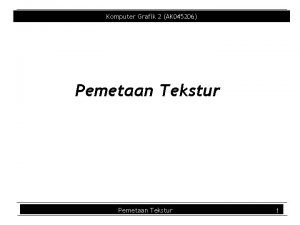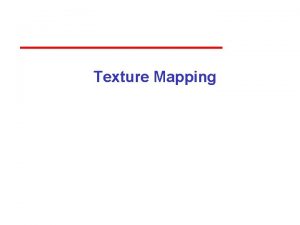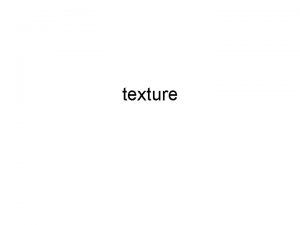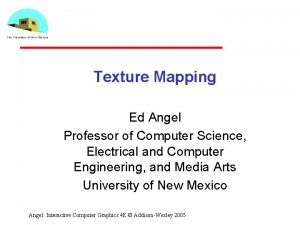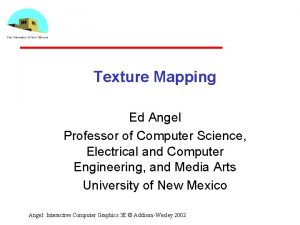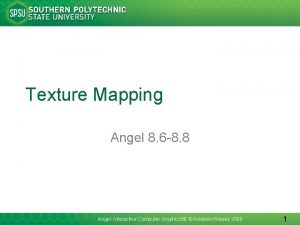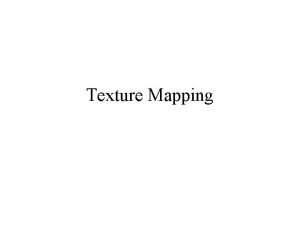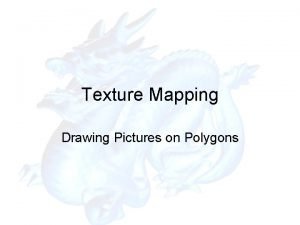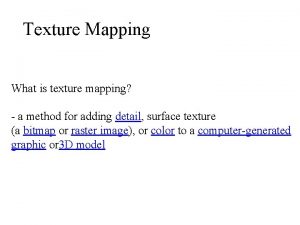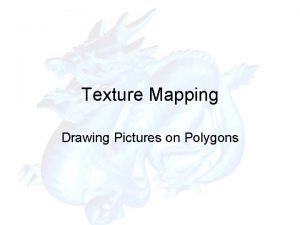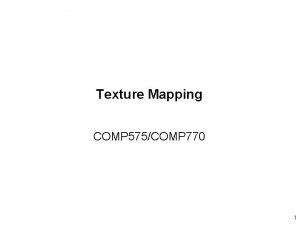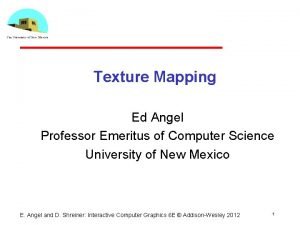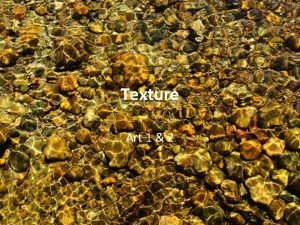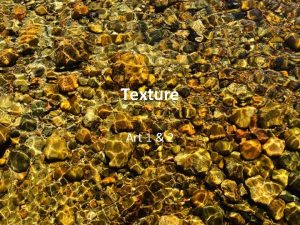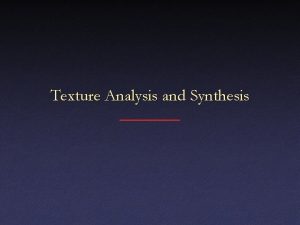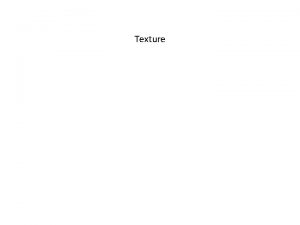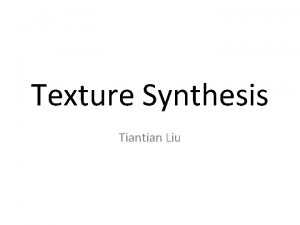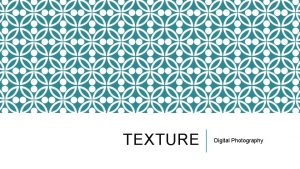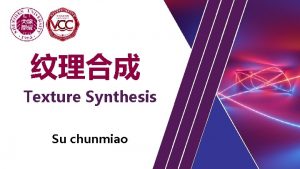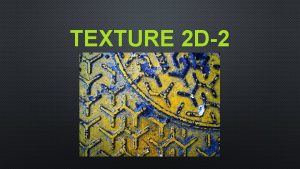Texture Mapping Ed Angel Professor of Computer Science






















- Slides: 22

Texture Mapping Ed Angel Professor of Computer Science, Electrical and Computer Engineering, and Media Arts University of New Mexico Angel: Interactive Computer Graphics 3 E © Addison-Wesley 2002

Objectives • Introduce Mapping Methods Texture Mapping Environment Mapping Bump Mapping • Consider basic strategies Forward vs backward mapping Point sampling vs area averaging Angel: Interactive Computer Graphics 3 E © Addison-Wesley 2002 2

The Limits of Geometric Modeling • Although graphics cards can render over 10 million polygons per second, that number is insufficient for many phenomena Clouds Grass Terrain Skin Angel: Interactive Computer Graphics 3 E © Addison-Wesley 2002 3

Modeling an Orange Consider the problem of modeling an orange (the fruit) • Start with an orange colored sphere • Too simple • Replace sphere with a more complex shape Does not capture surface characteristics (small dimples) Takes too many polygons to model all the dimples Angel: Interactive Computer Graphics 3 E © Addison-Wesley 2002 4

Modeling an Orange (2) • Take a picture of a real orange, scan it, and “paste” onto simple geometric model This process is known as texture mapping • Still might not be sufficient because resulting surface will be smooth Need to change local shape Bump mapping Angel: Interactive Computer Graphics 3 E © Addison-Wesley 2002 5

Three Types of Mapping • Texture Mapping Uses images to fill inside of polygons • Environment (reflection mapping) Uses a picture of the environment for texture maps Allows simulation of highly specular surfaces • Bump mapping Emulates altering normal vectors during the rendering process Angel: Interactive Computer Graphics 3 E © Addison-Wesley 2002 6

Texture Mapping geometric model texture mapped Angel: Interactive Computer Graphics 3 E © Addison-Wesley 2002 7

Environment Mapping Angel: Interactive Computer Graphics 3 E © Addison-Wesley 2002 8

Bump Mapping Angel: Interactive Computer Graphics 3 E © Addison-Wesley 2002 9

Where does mapping take place? • Mapping techniques are implemented at the end of the rendering pipeline Very efficient because few polygons make it past the clipper Angel: Interactive Computer Graphics 3 E © Addison-Wesley 2002 10

Is it simple? • Although the idea is simple map an image to a surface there are 3 or 4 coordinate systems involved 2 D image 3 D surface Angel: Interactive Computer Graphics 3 E © Addison-Wesley 2002 11

Coordinate Systems • Parametric coordinates May be used to model curved surfaces • Texture coordinates Used to identify points in the image to be mapped • Object Coordinates Conceptually, where the mapping takes place • Screen Coordinates Where the final image is really produced Angel: Interactive Computer Graphics 3 E © Addison-Wesley 2002 12

Texture Mapping parametric coordinates texture coordinates object coordinates Angel: Interactive Computer Graphics 3 E © Addison-Wesley 2002 screen coordinates 13

Mapping Functions Basic problem is how to find the maps • Consider mapping from texture coordinates to a point a surface • Appear to need three functions • x = x(s, t) y = y(s, t) z = z(s, t) (x, y, z) t But we really want to go the other way • s Angel: Interactive Computer Graphics 3 E © Addison-Wesley 2002 14

Backward Mapping • • We really want to go backwards Given a pixel, we want to know to which point on an object it corresponds Given a point on an object, we want to know to which point in the texture it corresponds Need a map of the form s = s(x, y, z) t = t(x, y, z) • Such functions are difficult to find in general Angel: Interactive Computer Graphics 3 E © Addison-Wesley 2002 15

Two-part mapping One solution to the mapping problem is to first map the texture to a simple intermediate surface • Example: map to cylinder • Angel: Interactive Computer Graphics 3 E © Addison-Wesley 2002 16

Cylindrical Mapping parametric cylinder x = r cos 2 p u y = r sin 2 pu z = v/h maps rectangle in u, v space to cylinder of radius r and height h in object coordinates s=u t=v maps from texture space Angel: Interactive Computer Graphics 3 E © Addison-Wesley 2002 17

Spherical Map We can use a parametric sphere x = r cos 2 pu y = r sin 2 pu cos 2 pv z = r sin 2 pu sin 2 pv in a similar manner to the cylinder but have to decide where to put the distortion Spheres are used in environment maps Angel: Interactive Computer Graphics 3 E © Addison-Wesley 2002 18

Box Mapping Easy to use with simple orthographic projection • Also used in environment maps • Angel: Interactive Computer Graphics 3 E © Addison-Wesley 2002 19

Second Mapping • Map from intermediate object to actual object Normals from intermediate to actual Normals from actual to intermediate Vectors from center of intermediate actual intermediate Angel: Interactive Computer Graphics 3 E © Addison-Wesley 2002 20

Aliasing • Point sampling of the texture can lead to aliasing errors miss blue stripes point samples in u, v (or x, y, z) space point samples in texture space Angel: Interactive Computer Graphics 3 E © Addison-Wesley 2002 21

Area Averaging A better but slower option is to use area averaging preimage pixel Note that preimage of pixel is curved Angel: Interactive Computer Graphics 3 E © Addison-Wesley 2002 22
 Refers to the surface
Refers to the surface Promotion from associate professor to professor
Promotion from associate professor to professor What is polynomial texture mapping (ptm)?
What is polynomial texture mapping (ptm)? Matlab texture mapping
Matlab texture mapping Texture mapping algorithm
Texture mapping algorithm Types of texture maps
Types of texture maps 2d texture mapping
2d texture mapping Summed area table
Summed area table Texture mapping
Texture mapping Texture mapping progressive meshes
Texture mapping progressive meshes The associative mapping is costlier than direct mapping.
The associative mapping is costlier than direct mapping. Forward mapping vs backward mapping
Forward mapping vs backward mapping Prinsip analisis dan desain
Prinsip analisis dan desain Subject science
Subject science Crt in computer graphics
Crt in computer graphics Contoh tekstur komputer
Contoh tekstur komputer Natural vs social science
Natural vs social science Branches of natural science diagram
Branches of natural science diagram Natural and physical science
Natural and physical science Applied science vs pure science
Applied science vs pure science Anthropology vs sociology
Anthropology vs sociology Wwwk-6.thinkcentral
Wwwk-6.thinkcentral Tragedy of the commons
Tragedy of the commons
